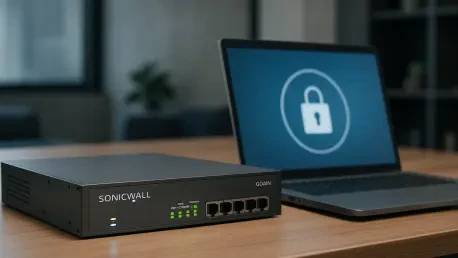Diving into the complex world of cybersecurity, I’m thrilled to sit down with Rupert Marais, our in-house security specialist with extensive expertise in endpoint and device security, cybersecurity strategies, and network management. Today, we’re exploring the recent wave of compromises targeting SonicWall SSLVPN devices, a pressing issue that has caught the attention of researchers and organizations alike. Our conversation will touch on the nature of these attacks, the tactics employed by hackers, potential connections to other incidents, and the broader implications for network security. Rupert will also share insights on how these events compare to past threats and what protective measures are crucial in today’s threat landscape.
How did the recent compromises of SonicWall SSLVPN devices come to light, and what’s the scale of the impact so far?
These compromises were flagged by researchers who noticed unusual activity targeting SonicWall SSLVPN devices. According to reports, over 100 accounts across 16 different customer environments have been affected. The attacks started around October 4th, and what’s alarming is that they seem to be ongoing, highlighting a persistent threat that organizations need to address urgently.
What sets these attacks apart from the typical hacking methods we often hear about?
What’s particularly striking is that these attackers aren’t relying on brute-force tactics, which are more common and involve guessing passwords through trial and error. Instead, they appear to have valid credentials, allowing them to log directly into multiple accounts with alarming speed. This suggests either a breach of credential security elsewhere or a sophisticated method to bypass authentication, which is a significant departure from standard attack patterns.
Can you elaborate on the timeline and speed of these logins, and what that might indicate about the attackers’ strategy?
The speed at which these hackers are accessing multiple accounts is really telling. They’re not fumbling around or testing combinations; they’re logging in almost instantly across different targets. This points to a high level of preparation, likely involving stolen or compromised credentials obtained prior to the attack. It’s a sign of a well-organized operation, possibly with insider knowledge or data from previous breaches.
There’s also been mention of issues with SonicWall’s MySonicWall cloud backup service. Could there be a link between these two incidents?
That’s a question many are asking. Both the SSLVPN attacks and the MySonicWall cloud backup compromises surfaced around the same time, which raises suspicion. However, there’s no concrete evidence yet to confirm a direct connection. Researchers are still investigating, and as of now, neither SonicWall nor the research teams have provided definitive clarity on whether these incidents are related or just coincidental.
Once the attackers gain access to these networks, what kinds of activities have they been engaging in?
The behavior varies. In some cases, the attackers log in and disconnect almost immediately, which could indicate they’re testing access or mapping out targets for a later, more focused attack. In other instances, they’ve been observed scanning the network or attempting to access local Windows accounts, suggesting they’re looking for ways to move laterally within the environment or escalate their privileges.
How do these recent attacks compare to the earlier incidents reported a few months back?
There are notable similarities to attacks reported in August, particularly those targeting SonicWall Gen 7 firewalls, which were linked to Akira ransomware. Both sets of attacks show a level of sophistication and focus on specific vulnerabilities within SonicWall systems. While the August incidents highlighted issues with improper access control, the current wave’s use of valid credentials adds a new layer of concern, showing that attackers are adapting their methods.
There was some speculation about a zero-day vulnerability in the earlier attacks. Can you walk us through what was initially suspected and how that panned out?
During the August attacks, researchers initially suspected a zero-day vulnerability—a previously unknown flaw that attackers could exploit. However, after investigation, SonicWall clarified that the issue stemmed from a known improper access control vulnerability, not a zero-day. They emphasized that many of these breaches occurred because customers hadn’t updated local passwords after upgrading their systems, which left them exposed.
What protective measures did SonicWall recommend following those earlier attacks, and do you think they still apply to the current situation?
After the August incidents, SonicWall strongly advised customers to rotate their local and LDAP account credentials to prevent unauthorized access. They highlighted the risks of using outdated passwords, especially after system upgrades. These recommendations are absolutely still relevant today, as credential security seems to be a central issue in the current attacks. Beyond that, organizations should also consider multi-factor authentication and regular monitoring for unusual login activity.
Looking ahead, what’s your forecast for the evolution of threats targeting VPN and network security solutions like these?
I think we’re going to see attackers continue to refine their methods, focusing on stealing or exploiting valid credentials rather than relying on brute-force or easily patchable vulnerabilities. As VPNs and remote access tools remain critical for businesses, they’ll stay prime targets. We can expect more blended attacks that combine social engineering, credential theft, and lateral movement within networks. Organizations will need to prioritize zero-trust architectures and proactive threat hunting to stay ahead of these evolving risks.









